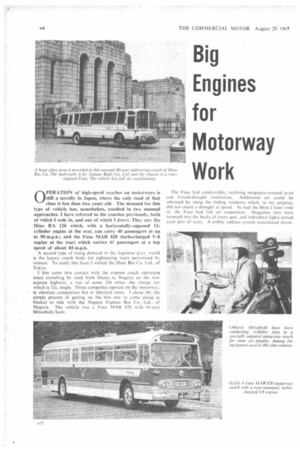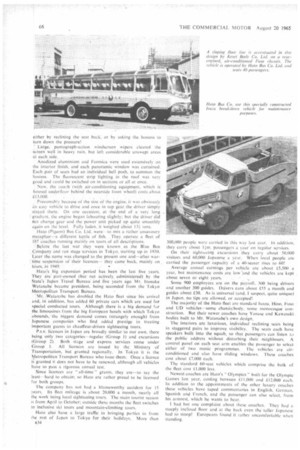Big Engines for Motorway Work
Page 66

Page 67

Page 68

If you've noticed an error in this article please click here to report it so we can fix it.
OPERATION of high-speed coaches on motorways is still a novelty in Japan, where the only road of that class is less than two years old. The demand for this type of vehicle has, nonetheless, resulted in two unusual approaches. I have referred to the coaches previously, both of which I rode in, and one of which I drove. They are: the Hino RA 120 which, with a horizontally-opposed 12cylinder engine at the rear, can carry 40 passengers al up to 90 m.p.h.; and the Fuso MAR 820 (turbocharged V-8 engine at the rear) which carries 41 passengers at 31 top speed of about 85 m.p.h.
A second type of rising demand in the Japanese p.s.v. world is the luxury coach body for sightseeing tours patronized by visitors. To study this facet I visited the Hato Bus Co. Lid.. of Tokyo.
. 1 first came into contact with the express coach operators when travelling by road from Osaka to Nagoya on the new express highway. a run of some 120. miles--the charge, for which is 12s. single. Three companies operate on the motorway, in absolute competition but at identical fares. 1 chose (by the simple process of getting on the first one to come along at Osaka) to ride with the Nippon Express Bus Co. Ltd.. of Nagoya. The vehicle was a Fuso MAR 820 Vt WI 41-seat Mitsubishi body, The Fuso had comfortable, reclining moquette-covered scats and forced-draught ventilation. Additional air could be obtained by using the sliding windows which, to .my surprise, did not create a draught at speed. As had the Hino 1 Paler rode in, the Fuso had full air suspension. Magazine nets were recessed into the backs of every seat, and individual lights served each pair of seats. A public address system transmitted music.
e is no pie-booking on these services, because traffic has mbed to a level where reservations are necessary. The re collected on board by the hostess (all these motorway s carry a hostess), Nippon Expres.s operate six journeys in. each direction. They have three types of vehicle on the the third being an Istizu DI1100H 42-seater with reard. six-cylinder engine of 10-litre capacity. le view of the driver of my Fuso coach (and he knew all :oaches). the Isuzu was underpowered for the job, It 'es 230 b.h:p. compared with the Fuso's 290 and the Hino's 1.p. (naturally aspirated).
.p.h. Speed Limit •
ride in the RISC was very .good, everywhere and noise back was not excessive. I could. however, notice engine the rear seats. Because there is a 50 m.p.h. speed limit, . on the motorway (to let Japanese drivers gradually )m themselves to speed) one can only accept the aeturers' top speed figures.
days later. when I was visiting 'Mitsubishi's Kawasaki near Yokohaina. I drove one of these coaches. With full tights. and six extra passengers it was grossing nearly 14 at handled beautifully. A power-assisted clutch and gear
t made light work of driving. The five-speed gearbox was y adequate and, in fact. once in 5th T found little need other than drop occasionally into 4th.
is pleasantly surprised to find practically no lag on the harger (except at very high r.p.rn.) and after cautiously he tachometer once or twice for gear changing, 1 gained :nee and dispensed with it. There was just enough road id engine noise to change gear " normally ".
d DO test equipment with me. hut had by that time driven
a considerable number of Japanese vehicles so could judge performance with reasonable accuracy. My overriding impression of this vehicle was its lively acceleration, extreme comfort and general ease of handling. I had cause to try the air brakes once, and found them capable .of pulling up the coach very quickly, although there was some lag in the system.
The vehicle I drove (which was illustrated last week) had a specially converted, all-glass front and had been on extensive visibility tests by Mitsubishi for about six months. Roller blinds were fitted top and bottom on each side of the divided front. and town and country driving conditions were being tested with various shutter openings. The company were not prepared to say too much about these tests except to state that they had established that widely differing visibility sections were needed for town work (deep screen) and motorway (almost a "strip " screen).
was also able to ride in one of the Hino coaches, with Kanazawa 40-scat body. used by Nippon Express Bus Co. was most surpriSed at the smoothness of the 16-litre engine and also by its quietness. In fact, a British automotive engineer who was travelling with me could not believe it was a 12-cylinder unit. The driver, however, suffered badly from this quiet running. He could rely only on his tachometer when changing gear an 6peration that became quite voluble on occasions!
The ride was good but gave rather more pitch than did the Fuso. The seats were, again, fully-reclining and very comfortable: but the luggage rack gave a lot less space than the Fuso's. This vehicle had air conditioning with air outlets at floor and waist level for each pair of seats.
The floor outlets could be controlled by the passengers, and were on a lower pressure than the waist-level ones. These were, in fact, on occasions a slight nuisance. The air flow to the waist-level outlets was controlled by the driver, and at fullpressure caused quite a draught on to the face of the passenger nearest the window. However. I found it could be avoided
either by reclining the scat back. or by asking the hostess to turn down the pressure!
Large. pantograph-action windscreen wipers cleared the screen well in heavy rain, but left considerable unswept areas at each side.
Anodized aluminium and Formica were used extensively on the interior finish, and each panoramic window was curtained. Each pair of seats had an individual bell push, to summon the hostess. The fluorescent strip lighting in the roof was very good and could be switched on in sections or all at once.
New, the coach.(with air-conditioning equipment, which is housed underfloor behind the nearside front wheel) costs about
f13.000. ,
Presumably because of the size of the engine. it IA as obviously an easy vehicle to drive and once in top gear the driver simply stayed there. On one occasion, at the end of a very long ' gradient. the engine began labouring slightly; but the driver did not change-gear and the power Unit picked up quite smoothly again on the level. Fully laden. it Weighed about 131 tons. Hato (Pigeon) Bus Co_ Ltd. were --to mix a rather unsavoury metaphor—a different kettle of fish. , They operate a fleet of 185 cbaches running mainly on tours of all descriptions.
BefOre the last war they were known, as -the Blue Bus ComPany and ran stage szrvices in Tokyo. starting up in 1930. Later the name was changed to the present one and—after wartime suspension of their licences— they came back, mainly on ttiurs. in 1-949. . •
Ham's big expansion .period has been the last five years. They Are part-owned (but not actively, administered) by the States •JaPan Travel Bureau and five years ago Mr. Inosuke Watanabe became president. being seconded from the Tokyo Metropolitan Transport Bureau.
Mr. -Watanabe has doubled the Hato fleet since his arrival and. in addition, has added 60 private cars which are used for special conducted tours. Although there is a big demand for the limousines from the big European hotels with which Tokyo abounds, the biggest demand comes (strangely enough) from Japanese companies who find added prestige in treating important guests to chauffeur-driven sightseeing tours.
P.s.v. licences in Japan are broadly similar to our own, there being only two .categories—regular (Group 1) and excursions (Group 2). Both stage and express services come under Group I. All .licences are issued by the Ministry of Transportation, but granted regionally. In Tokyo it is the Metropolitan Transport Bureau who issue them. Once a licence is granted it does not have to be renewed, although all vehicles have to pass a rigorous annual test.
Since licences are " all-time " grants. they are—to say the leasthard to obtain; so Hato are rather proud to be licensed for both groups.
The company has not had a blameworthy accident for 15 years. Its fleet mileage is about 20.000 a month, nearly all the work being local sightseeing tours. The main tourist season is from April to October: outside these months the fleet switches to inclusive ski tours and mountain-climbing tours.
Hato also have a large traffic in bringing parties in from the rest of Japan to Tokyo for their holidays. More than 534
300,000 people were carried in his v, ay last In addition,
they carry about lm. passengers a Year onregitlar services.
On their sightseeing excursions they carry about 50.000 visitors and 60,000 Japanese a ye:tr. When local people are carried the passenger capacity of a 40-seater rises to 60!
Average annual earnings per vehicle are about £5,500 a year, but maintenance costs are low 'and the vehicles are kept about seven or eight years.
Some 900 employees are on the payroll. 300 being drivers and another 300 guides. Drivers earn about £55 a month and guides about £30. As is universal (and. I suspect, quite unique) in Japan. no tips are allowed, or accepted!
The majority of the Hato fleet arc standard 1w/it, Hino, Fuso and UD vehicles—some chassis/body, some monocoque construction. But their newer coaches have Yanase and Kawasaki bodies built to Mr. Watanabe's own design.
The interiors are luxurious, individual reclining seats being in staggered pairs to improve visibility. The seats each have speakers built into the squab, so that passengers can listen to the public address without disturbing their neighbours. A control panel on each scat arm enables the passenger to select either of two music programmes. The vehicles are airconditioned and also have sliding windows. These coaches cost about £7,000 each.
The standard 60-seat vehicles which comprise the bulk of the fleet Cost £1.000 less.
Newest coaches are Hato's "Olympics" built for the Olympic Games last year. costing between £11,000 and £12,000 each. In addition to the appointments of the other luxury coaches these vehicles have taped commentaries in English, German, Spanish and French, and the passenger can also select, from his armrest, which he wants to hear.
I had but one complaint about these coaches. They had a steeply inclined floor and at the back even the taller Japanese had to stoop! Europeans found it rather uncomfortable when standing.




















































































































